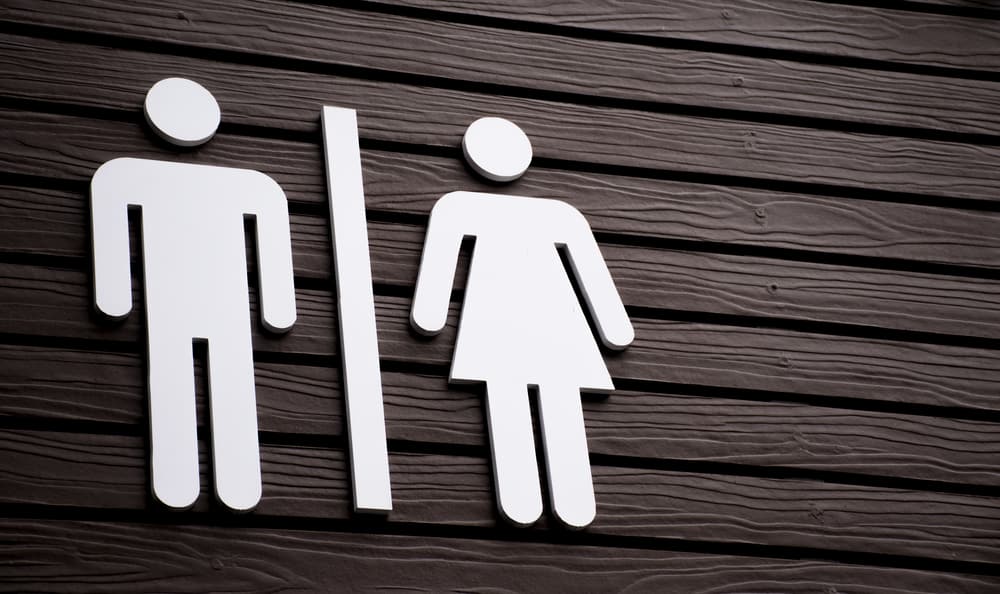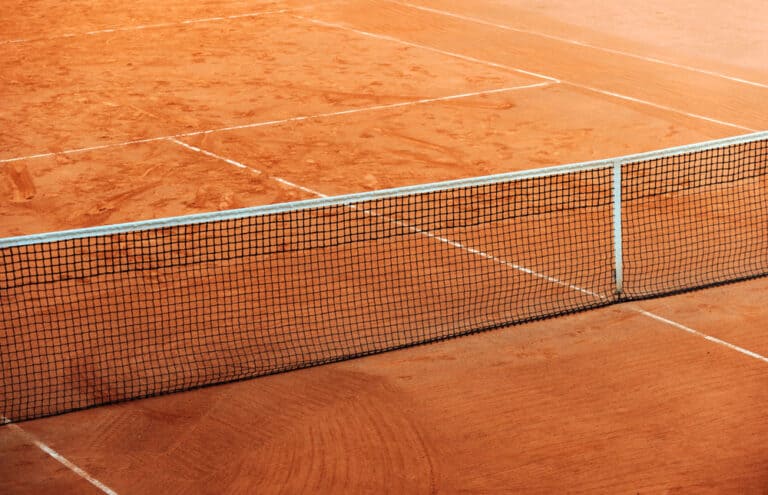Can You Use The Toilet During A Tennis Match?
The issue of tennis players using the bathroom has become somewhat of a smelly issue over the past few years. Human decency dictates that we will never see the option of a bathroom break being banned outright. After all, matches in the grand slam tournaments have been known to last 5 hours or even longer, so players will need to use the restroom at some stage.
Players are permitted to use the toilet during a tennis match. The time limit is 3 minutes from the moment the player enters the toilet and can be extended by 2 further minutes if the player changes clothing. Players may have 1 toilet break each in a 3-set match and 2 breaks in a 5-set match.
Let’s dig a little deeper into why the issue of bathroom breaks has become such an issue in recent years.
Can You Use The Toilet During A Tennis Match
Currently, the ATP rule book states that toilet breaks can only be taken during the break between sets. Players are allowed one break each during a 3-set match and two breaks each during a 5-set match. This limitation is logical as there are a maximum of 2 set breaks during a 3-set match and 4 set breaks during a 5-set match.
The WTA has a similar rule in place, but because the women’s tour only has 3-set matches, players are limited to one toilet break each.
Technically the rules state that a toilet break should be taken for no other purpose than a toilet break. However, in practice, I have seen the bathroom breaks on the women’s tour used to change into a fresh tennis dress during matches played in hot/humid conditions. While the men change a shirt while sitting courtside during a changeover, the women will take a fresh dress from their tog bag in its packaging and hold it up to the umpire, indicating that they wish to change dresses, and the umpire will approve the bathroom break for that purpose.
Are You Allowed To Go To The Toilet During A Tennis Match?
Players are permitted to go to the toilet during a tennis match. This is currently limited to a three-minute break and only during the breaks between sets. Players are entitled to one break each during a 3-set match and two breaks each during a 3-set match.
However, the rules were much more relaxed in the past, where players were not limited to the number of toilet breaks or their duration. The rule change was brought about after the 2021 US Open when Andy Murray accused Stefanos Tsitsipas of cheating by gaming the bathroom break system to disrupt Murray’s rhythm in the game. Tsitsipas, from his side, stated that he had not broken any rules – which was true for that time.
The accusation arose because Tsitsipas left the court at various times during his marathon first-round match against Murray – and always at critical moments when Murray was beginning to take control of the match. It started with a lengthy toilet break after the second set, a medical time-out after the end of the third set, and a toilet break lasting nearly eight minutes between the fourth and fifth sets. The pattern repeated itself during the second-round match as well when Tsitsipas suddenly needed a bathroom break lasting more than seven minutes after losing the third set.
Under the old rules, players could only take a bathroom break before it was their service so as not to disrupt their opponent’s service. This leads me to another observation that might bring about a rule change in the future. I have noticed that, seemingly every time Tsitsipas loses a service game, he will slowly walk to his bag to get a new racket – especially if the players are not at a changeover. To me, this seems a deliberate attempt to disrupt an opponent’s rhythm immediately before they start their service game. Again, this is within the rules that a player is permitted to change rackets if their racket is damaged – like a broken string, for example.
How Long Can You Go To The Bathroom During A Tennis Match?
Following the Tsitsipas incident at the US Open, the length of a toilet break is limited to three minutes and can only be taken during a set break. However, the players’ cloakrooms are often some distance away from the courtside. Therefore, the three minutes are timed from when a player enters the bathroom and does not include the time taken walking to and from the bathroom.
Players are permitted to extend the bathroom break by a further 2 minutes in order to change into fresh clothes.
Can Tennis Players Go To The Toilet During A Match At Wimbledon?
Wimbledon has its own unique set of rules regarding bathroom breaks. These rules are phrased differently to make them unique to the London grass-court tournament.
In terms of the Wimbledon rules, players are permitted to “request permission to leave the court for a reasonable time for a toilet break.” The break must be taken during a set break and cannot be used for any other purpose. These rules are very similar to what the ATP and WTA have in their rulebooks, and, in practice, the rule is applied in the same way.
The Wimbledon rules deviate from the WTA rulebook in that both male and female players are allowed two toilet breaks per match even though the women play 3-set matches. Doubles teams are allocated two toilet breaks per team and therefore must share their allocated number of breaks.
The Wimbledon rulebook also states, “the nearest assigned bathroom to the court should be used”. This means that players cannot return to their changing room for a toilet break as this might be many minutes away from the court. One of the line judges must accompany the player to ensure that they “do not use the break for any other purpose”. From a practical perspective, changing into fresh clothes is part of the “intended purpose” of the bathroom break. This is why you will often see female players hold up their change of clothes in their plastic wrapping when they request a bathroom break from the umpire.
Did They Change The Bathroom Rule In Tennis?
There was a rule change made by the ATP at the start of the 2022 season that during men’s professional tournaments, players were entitled to only one bathroom break during a match and that break could not exceed three minutes. The bathroom break also had to happen between sets.
Most of the tournaments on the ATP circuit are played as the best of three sets. Only the grand slam tournaments are played as the best of 5 sets. Therefore, at the non-grand slam events, there are only two potential breaks between sets that can be used for a bathroom break, so limiting the players to only one bathroom break per match does not make that big of a difference.

How Many Toilet Breaks Are Allowed In Tennis?
All players have the right to a toilet break when they really need to answer the call of nature. However, as was shown in the Tsitsipas incident at the 2021 US Open, the toilet break can be used to game the system and disrupt the rhythm or momentum of an opponent.
The WTA and ATP are consistent with their new rules that were brought in to try and reduce the possibility of players manipulating toilet breaks to gain an advantage. During 3-set matches, players are entitled to one toilet break each, and the toilet break must be taken during the break between sets.
The ATP added a special rule for grand slam tournaments where each player is entitled to two toilet breaks during a 5-set match.
In the interests of equality, Wimbledon amended their rules to allow female players to have two toilet breaks even though the women’s tournament consists of 3-set matches.
Why Do Tennis Players Take Long Bathroom Breaks?
The practice of taking long bathroom breaks during a tennis match has for a long time been seen as a tactic that a player can use to break the momentum of an opponent if they are losing.
Following the Tsitsipas affair at the US Open in 2021, bathroom breaks have been limited to 3 minutes, but this can be extended to 5 minutes if the player is changing their clothes during the bathroom break.
Many commentators seem to be under the impression that there are no time limits on bathroom breaks. This is because the bathrooms at some venues are some distance away from the court. It would be unfair to a player who needs the bathroom to penalize them if it takes 2 minutes to walk from the court to the bathroom. Therefore, the timing of the bathroom break is measured from when the player enters the bathroom.
When a player goes to the bathroom, they are accompanied by one of the line judges. The line judge is there both to ensure that the player does not receive any coaching during the bathroom break as well as to ensure that the player does not exceed their 3 minutes or 5 minutes in the case of a clothing change.
After the bathroom break, the walk back to the court is not part of the 3-minute time allocation in the rules. Therefore, it is entirely possible that a player could be away from the court for as long as 8 minutes for a bathroom break if they are changing clothes as well. Because the time to walk to and from the bathroom varies between venues, it has led many to believe that there is no time limit on bathroom breaks.
Who Takes Long Bathroom Breaks In Tennis?
The most famous incident of a player taking a long bathroom break was Stefanos Tsitsipas at the US Open in 2021, where he took much longer than normal toilet breaks during both of the opening two rounds and always at critical points where his opponents had momentum. This prompted his opening-round opponent, Andy Murray, to tweet: “Fact of the day. It takes Stefanos Tsitsipas twice as long to go to the bathroom as it takes Jeff (Bezos) to fly into space.”
However, Tsitsipas did not pioneer the longer bathroom break as a tactical weapon.
Another player who successfully used the bathroom break/clothing change tactic was Novak Djokovic. The renowned tennis coach Patrick Mouratoglou said that from Novak Djokovic that Tsitsipas had learned the tactic. He realized that Djokovic took a bit of time for himself in the locker room to reset mentally and come back stronger. Tsitsipas learned that tried it for himself, and it worked well for him. That is why he continued to use bathroom breaks to both reset and disrupt an opponent who had momentum.
The problem was that Tsitsipas pushed the limit of what was a reasonable amount of time for a bathroom break too far, and that has led to the introduction of the 3-minute limit for bathroom breaks and an extra 2 minutes for changing clothes.
The Casper Ruud Tennis Bathroom Break Controversy
As you can imagine, it would only be a matter of time before the new toilet break rules resulted in their first incident. The incident happened at the Montreal Masters tournament during the match between Roberto Bautista Agut and Casper Ruud. The Norwegian tennis player, Ruud, was fined for not actually using the toilet during an official bathroom break midway through the match.
Ruud had been off the court for 11 minutes in order to change his clothes. However, he failed to actually go to the toilet. When he returned to the court, he was confronted by umpire Fergus Murphy for being in violation of the rules.
Initially, Murphy pointed out that Ruud had exceeded the allotted five minutes by more than double. However, the umpire had measured the time from when Ruud left the court and not when he entered the bathroom and so failed to count the time it took to walk to the bathroom and back.
Even though the umpire couldn’t penalize Ruud for the time violation, he did issue an official warning for not using the toilet during his bathroom break.
Murphy, the umpire, explained that changing clothes was covered by the bathroom break rule. A player is permitted to change their clothes, but they actually have to go to the toilet when they say they are going to the bathroom.
During the heated exchange, Ruud explained that he had clearly told the umpire he was only going off the court to change his clothes. Murphy, the umpire, confirmed that he had heard what Ruud had said but insisted that the rules stated that the player was obliged to use the toilet while off the court. The result of the incident was that Ruud received an official warning for unsportsmanlike conduct.
When a player receives a warning for unsportsmanlike conduct, there is an automatic fine. The amount of the fine is decided by the tournament referee on a case-by-case basis but may not exceed $20,000. On a practical level, a fine for unsportsmanlike conduct is seldom less than $3,000.







